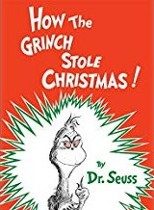 Dr. Seuss •
Dr. Seuss •
How the Grinch Stole Christmas! •
For the baby boom generation, Dr. Seuss is an old and trusted friend. It was his tongue-twisting rhymes that helped many of us learn to read; his wacky drawings that sent us into fits of giggles at story hour. We cut our literary teeth chewing Green Eggs and Ham.
Among some four dozen children’s books authored and illustrated by Theodor Seuss Geisel, How the Grinch Stole Christmas! is special for several reasons. The Grinch—like Scrooge—has passed into our collective vocabulary: Webster’s defines a grinch as a “killjoy” or “spoilsport,” someone mean-spirited and petty-minded, intent on destroying the pleasures of others.
What’s the Grinch’s problem? “It could be his head wasn’t screwed on just right. / It could be, perhaps, that his shoes were too tight. / But I think that the most likely reason of all / May have been that his heart was two sizes too small.” The Grinch just can’t stand to see the Whos down in Who-ville celebrating Christmas, so he sets out to steal every tree, every present, every string of lights, every roast beast. That’ll fix them!
Seuss packs a world of feeling into his cadenced poetry, and the short, simple story carries a cultural significance well beyond its inventive plot. Much like A Charlie Brown Christmas, it gently derides the overwhelming commercialism of the season and points us instead toward less materialistic causes for celebration. “Maybe Christmas,” thinks the Grinch, “doesn’t come from a store. / Maybe Christmas . . . perhaps . . . means a little bit more!” Because when the Whos wake up on Christmas morning to find all the holiday trappings gone, they still join hands and sing for sheer joy.
And all the Whos in Who-ville can’t be wrong.






Your email address will not be published.